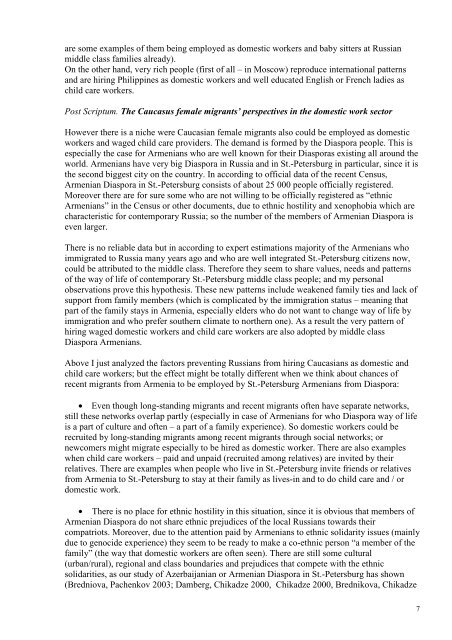?Caucasian? female labor migration in contemporary Russia ...
?Caucasian? female labor migration in contemporary Russia ...
?Caucasian? female labor migration in contemporary Russia ...
You also want an ePaper? Increase the reach of your titles
YUMPU automatically turns print PDFs into web optimized ePapers that Google loves.
are some examples of them be<strong>in</strong>g employed as domestic workers and baby sitters at <strong>Russia</strong>n<br />
middle class families already).<br />
On the other hand, very rich people (first of all – <strong>in</strong> Moscow) reproduce <strong>in</strong>ternational patterns<br />
and are hir<strong>in</strong>g Philipp<strong>in</strong>es as domestic workers and well educated English or French ladies as<br />
child care workers.<br />
Post Scriptum. The Caucasus <strong>female</strong> migrants’ perspectives <strong>in</strong> the domestic work sector<br />
However there is a niche were <strong>Caucasian</strong> <strong>female</strong> migrants also could be employed as domestic<br />
workers and waged child care providers. The demand is formed by the Diaspora people. This is<br />
especially the case for Armenians who are well known for their Diasporas exist<strong>in</strong>g all around the<br />
world. Armenians have very big Diaspora <strong>in</strong> <strong>Russia</strong> and <strong>in</strong> St.-Petersburg <strong>in</strong> particular, s<strong>in</strong>ce it is<br />
the second biggest city on the country. In accord<strong>in</strong>g to official data of the recent Census,<br />
Armenian Diaspora <strong>in</strong> St.-Petersburg consists of about 25 000 people officially registered.<br />
Moreover there are for sure some who are not will<strong>in</strong>g to be officially registered as “ethnic<br />
Armenians” <strong>in</strong> the Census or other documents, due to ethnic hostility and xenophobia which are<br />
characteristic for <strong>contemporary</strong> <strong>Russia</strong>; so the number of the members of Armenian Diaspora is<br />
even larger.<br />
There is no reliable data but <strong>in</strong> accord<strong>in</strong>g to expert estimations majority of the Armenians who<br />
immigrated to <strong>Russia</strong> many years ago and who are well <strong>in</strong>tegrated St.-Petersburg citizens now,<br />
could be attributed to the middle class. Therefore they seem to share values, needs and patterns<br />
of the way of life of <strong>contemporary</strong> St.-Petersburg middle class people; and my personal<br />
observations prove this hypothesis. These new patterns <strong>in</strong>clude weakened family ties and lack of<br />
support from family members (which is complicated by the im<strong>migration</strong> status – mean<strong>in</strong>g that<br />
part of the family stays <strong>in</strong> Armenia, especially elders who do not want to change way of life by<br />
im<strong>migration</strong> and who prefer southern climate to northern one). As a result the very pattern of<br />
hir<strong>in</strong>g waged domestic workers and child care workers are also adopted by middle class<br />
Diaspora Armenians.<br />
Above I just analyzed the factors prevent<strong>in</strong>g <strong>Russia</strong>ns from hir<strong>in</strong>g <strong>Caucasian</strong>s as domestic and<br />
child care workers; but the effect might be totally different when we th<strong>in</strong>k about chances of<br />
recent migrants from Armenia to be employed by St.-Petersburg Armenians from Diaspora:<br />
• Even though long-stand<strong>in</strong>g migrants and recent migrants often have separate networks,<br />
still these networks overlap partly (especially <strong>in</strong> case of Armenians for who Diaspora way of life<br />
is a part of culture and often – a part of a family experience). So domestic workers could be<br />
recruited by long-stand<strong>in</strong>g migrants among recent migrants through social networks; or<br />
newcomers might migrate especially to be hired as domestic worker. There are also examples<br />
when child care workers – paid and unpaid (recruited among relatives) are <strong>in</strong>vited by their<br />
relatives. There are examples when people who live <strong>in</strong> St.-Petersburg <strong>in</strong>vite friends or relatives<br />
from Armenia to St.-Petersburg to stay at their family as lives-<strong>in</strong> and to do child care and / or<br />
domestic work.<br />
• There is no place for ethnic hostility <strong>in</strong> this situation, s<strong>in</strong>ce it is obvious that members of<br />
Armenian Diaspora do not share ethnic prejudices of the local <strong>Russia</strong>ns towards their<br />
compatriots. Moreover, due to the attention paid by Armenians to ethnic solidarity issues (ma<strong>in</strong>ly<br />
due to genocide experience) they seem to be ready to make a co-ethnic person “a member of the<br />
family” (the way that domestic workers are often seen). There are still some cultural<br />
(urban/rural), regional and class boundaries and prejudices that compete with the ethnic<br />
solidarities, as our study of Azerbaijanian or Armenian Diaspora <strong>in</strong> St.-Petersburg has shown<br />
(Bredniova, Pachenkov 2003; Damberg, Chikadze 2000, Chikadze 2000, Brednikova, Chikadze<br />
7
















